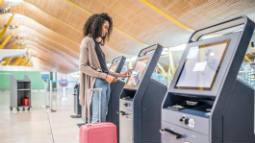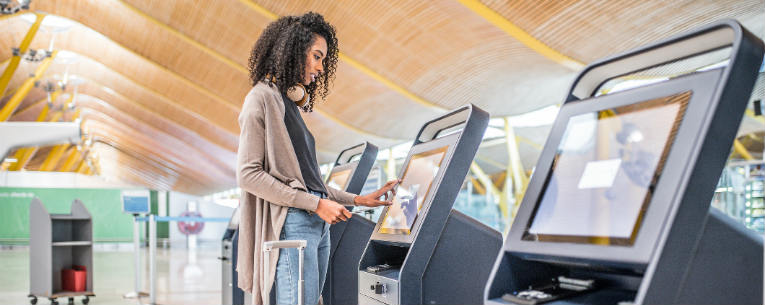More than 2.5 million people board domestic flights in the United States. Every day.1
That’s a whole lot of TSA body pat-downs and airline-issued ½-oz. bags of snack mix.
And among all the well-travelled fliers, with their fancy carry-on bags and “been there, done that” confidence, are those travelers flying for the first time. These are the newbies, the white-knucklers who triple-check their seat belts and ask lots of questions.
“Is it my turn to board?”
“Is that noise normal?”
“What’s that bag for in the seat-back pocket? Oh wait, I know…”
We all remember that moment of flying for the first time. (OK, maybe not; some of us were babies.) And if you’re preparing for that moment, which makes sense because you’re reading this article, we have tips and advice to make airline travel a breeze.
We’ve covered it all here, from the packing to making it through the TSA hoops and hurdles. So sit back, buckle up and prepare for take-off. We’re about to take you on a journey from clueless first-time flyer to experienced mile-high passenger.
Steps to Take Before Flying for the First Time
If you’re anxious or simply a little uncertain about flying for the first time, you can do a lot in the weeks leading up to your flight to ease any apprehension.
This begins with your very first step: making sure you have the needed travel documents to get on the plane, step off at your destination and fly back home. If you’re flying domestically, a valid Driver’s License, military ID, permanent resident card or border-crossing card will work. Kids 15 to 17 years may need some form of ID; a school ID card will usually get the job done (check with the airline first). Kids 14 and under are usually fine to fly without any official paperwork, but again, check with the airline to see if a birth certificate is needed.2
When you’re leaving the country, things get a bit more complicated. You’ll need a valid U.S. Passport — begin the application process at least six weeks before your departure to be safe — and depending on your destination, you may require a travel visa as well. Don’t worry, we have helpful guides to walk you through the passport and visa application process.
Next up? Buying the airline ticket(s). Pulling the trigger on airfare can be as easy as calling up or visiting an airline’s website. But the options for buying a ticket are as you might imagine: plentiful. You can take advantage of flight aggregator sites such as Kayak.com, get the assistance of a travel agent, decide between two one-way tickets or a single roundtrip fare, book through a discount airline such as Spirit Airlines, or take a shot at flying standby. But if you want to keep things easy, simply visit an airline site. And to make it even easier, look for direct flights as opposed to chunking your trip up with connecting flights and layovers.
Frequent fliers may tell you that one of the most critical steps to having a comfortable flight is finding the right seat. Whether you’re booking First Class, faking First Class, looking for a little extra legroom or just looking to avoid a middle seat between two strangers, there is a way to make the best of your situation. Before you decide if you want to pay a premium for a seat, take a peek at SeatGuru’s seating maps to glean extra information and even passenger reviews. Here you can find if a potential seat is too close to the lav for comfort or if a window seat lacks a clear view out a window. (Trust us, you don’t want to promise a window seat to your kid and then have just an inch of daylight peering back at you.) So take a look at available seats before booking, reserve the seats where you’re most comfortable, and there is one last surprise to worry about as you make your maiden voyage.3
OK, you’ve got your travel documents, your ticket, and your seat. Now you just need to take care of your stuff. Here is a quick plan of attack for packing. First, look at the length of your trip, the needed wardrobe and whether or not you’ll have access to a washer, dryer, and even dry cleaner. Then eyeball your airline’s policy and pricing around both carry-on bags and checked luggage You can often bring one carry-on and a personal item — purse, laptop bags, etc. — onto the plane at no cost. Checked bags usually carry a fee, ranging from the standard $25 fee for the first bag on most domestic carriers, including Delta and American Airlines, to more than $200 for oversize bags.4 (Yes, packing your bags and weighing them in advance is a good idea.)
Determining what to bring, especially if you’re trying to squeeze a week’s worth of clothes into a single carry-on bag, can be challenging. Good news. We have packing guides to light the way; lots and lots of packing guides, whether you’re heading out on summer vacation, travelling with small kids, or taking a last-minute business trip.
Perhaps the packing wrinkle that gives those flying for the first time the most anxiety is the TSA liquid rules. Here is what you need to know: If you put your shampoo, deodorant and other liquids, aerosols, gels, creams and pastes in a checked bag, you’re good to go. But if you want to stow them in your carry-on bag, then you need to follow TSA protocol. Start with a quart-sized plastic bag; then fill it with travel-sized containers (3.4 oz. or less) until you’ve checked off your personal items or the bag is full, whatever comes first. So if you’re a big hair product person, you might have to make some hard choices, or simply buy a few items at the store after you land.5
Troubleshooting 101: What can go wrong before you even leave the ground? Plenty on your end. What if you come down with a bad virus before jetting, and your doctor advises you to stay at home. Or totally out of left field, your company lays you off? Or you get caught up in 10-car fender bender on your way to the airport? You just may need to cancel your trip. And it could be more than inconvenient; it could cost you money. The good news is that if you have travel insurance through Allianz Global Assistance, and your reason for needing to cancel is covered by your policy, you may get reimbursed for your nonrefundable, pre-paid expenses. With travel insurance, you pack peace of mind, and there are no TSA restrictions on that.
At the Airport & Beyond…
You’re booked, packed and wearing a pair of comfy shoes. You may be flying for the first time, but you’re good to go.
So keep the momentum going strong by checking in for your flight online. That’s right, you don’t need to wait at the airline counter (unless you have some very special circumstances.) Most airlines allow you to check in online within 24 hours of your scheduled departure; just have your confirmation number handy. During this process, you’ll be able to pay for checked bags as well, which you’ll need to drop off at the airline’s ticketing counter. You may also be offered the option to change your seat, depending on how full the flight is, and even upgrade to premium Coach seating or First Class. Then you can print your boarding pass, use your phone as a mobile boarding pass (depending on your airline and departure city) or simply print it out at a check-in kiosk after arriving at the airport.6
Next, you need to get to the airport. Figure out in advance if you’re driving (and where you’re parking), or getting a ride from a friend, cab or service such as Uber and Lyft. You’ll want to arrive about two hours ahead of your departure time for domestic flights and three hours for international flights. Read this next sentence twice as it’s very important: your departure time is not your boarding time. You’ll be asked to board at least 30 minutes before your flight, so check your ticket or the airport monitors to ensure you’re at the right gate in plenty of time. (Tip: The Allyz® app can show you your flight status and gate in one location.)
Because you’re a first-time flier, play it safe at the airport by heading straight for the TSA checkpoint, where you’ll be asked to present your ID and boarding pass. From there, you’ll also be instructed to remove your shoes, belt, and other accessories, placing them in provided plastic bins to be screened via metal detector. You’ll also need to pull out laptops, your clear plastic bag of liquids, and other items such as C-PAP machines. From there, just walk through the body scanner, and if you’re asked to undergo a pat-down or additional screening, our best advice is to comply and be cordial.7 Then grab your items from the bins and put yourself back together.
That’s it. If you’re flying for the first time, and you’ve gotten this far, you’ve completed all the most stressful steps (and no, they’re not that bad). It’s time to head toward the gate indicated on your boarding pass, board when your zone number is called, stow your bags and look for your seat. Then read the safety pamphlet, watch the seatbelt demonstration and figure out if you’ll catch some shuteye, churn through some work or chat up your row-mate during the flight. Or maybe you’ll just stare into the seat back in front of you while gripping the armrest and sweating. A lot. It’s natural to feel nervous when you feel turbulence at 30,000 feet or if you’re unsure whether it’s impolite to put your tray table down mid-flight, but don’t worry. We have tips for overcoming your fear of flying and practicing proper travel etiquette. Also, if you need to catch a connecting flight, and have a lengthy wait, we’ll help you make the most of your layover.
Troubleshooting 101: Trip delays happen. Perhaps your plane has a mechanical issue (not as scary as it sounds). Or maybe your crew got stuck in Minneapolis. Or your baggage did. No worries; with travel insurance from Allianz Global Assistance, you can get reimbursed for meals and accommodations to get you back on track — as well as prepaid, nonrefundable expenses. Baggage delay protection can reimburse you for essential items you need to purchase until you can get reunited with your Gucci GG Supreme Suitcase. You’ll want to carefully vet travel insurance policies to find the best fit for you, but travel insurance can help those flying for the first time relax and enjoy the ride.8
There’s really nothing to flying. All you need to do is plan ahead, follow instructions, and be ready to roll with the punches. Oh, and we almost forgot to mention: Don’t forget to pick up your checked bags at the baggage claim carousel after the flight. And never, ever keep your car keys in a checked bag. Trust us, you’d rather deal with a little extra jingle in your pocket or purse than calling locksmiths from an airport parking lot on a Sunday at 2 a.m.
Happy flying!
Related Articles








Share this Page